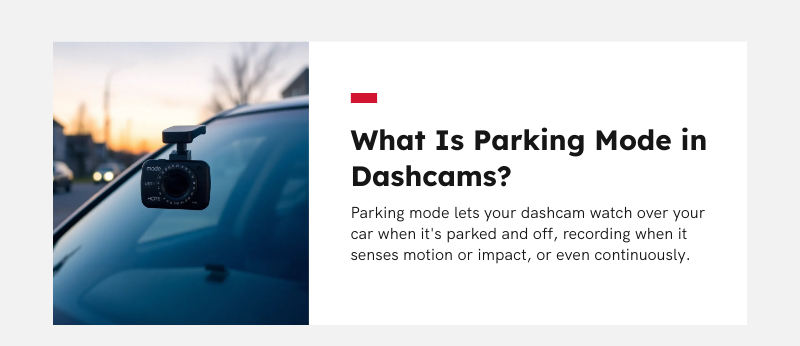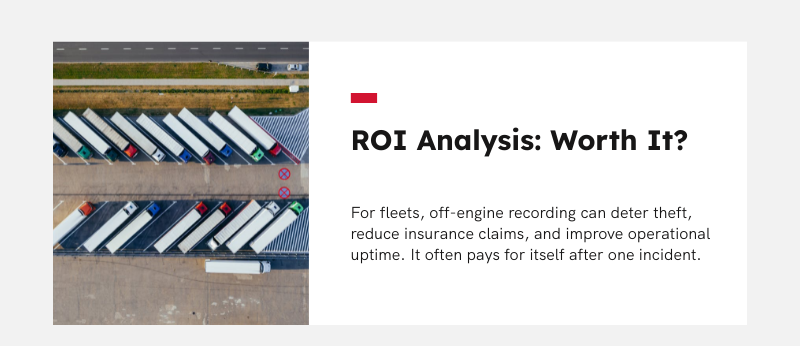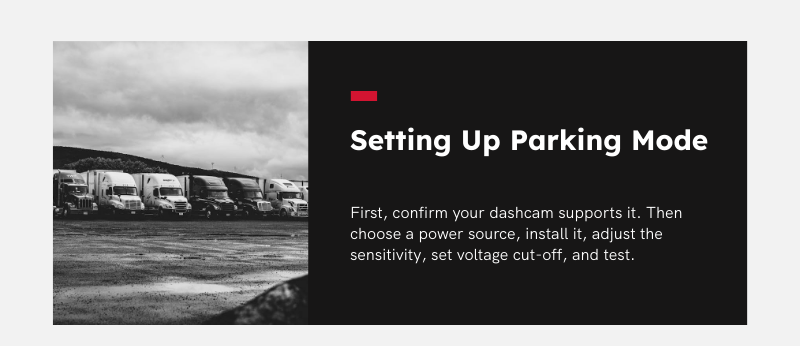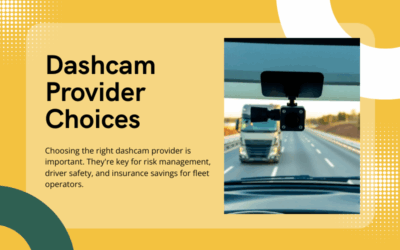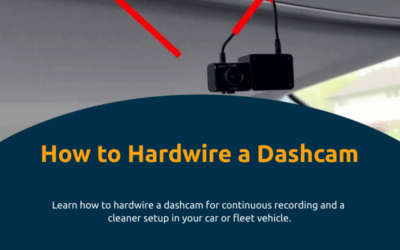Dashcams have become a standard safety and accountability tool for drivers, from everyday commuters to professional fleet operators. They capture real-time video while driving, often providing critical evidence in the event of accidents, disputes, or fraudulent claims. But one question comes up repeatedly:
Do dashcams record when the car is off?
The short answer: Yes — but only if the dashcam is equipped with a feature like parking mode or connected to a continuous power source.
How Dashcams Are Normally Powered
To understand whether dashcams record when a car is off, it’s important to start with the basics of how they receive power.
- Cigarette Lighter/Accessory Power:
Most dashcams plug into the car’s 12V socket (formerly cigarette lighter). These sockets usually only provide power when the ignition is on. Once the car is turned off, power is cut, and recording stops. - Hardwiring Kits:
A hardwire kit connects the dashcam directly to the vehicle’s fuse box. This allows the device to draw power continuously, even after the ignition is off, depending on how it’s wired. - OBD-II Power Adapters:
Some dashcams can be powered through the OBD-II port. Like hardwiring, this may allow for constant power delivery if configured properly. - Battery Packs:
Dashcams can also run on an external battery pack designed for extended off-engine recording. These packs recharge while driving and discharge when the vehicle is off.
Key takeaway: If your dashcam is only plugged into the 12V socket, it will not record when the car is off. To enable off-engine recording, it needs either a hardwire connection, a dedicated battery, or a specific parking mode feature.
What Is Parking Mode in Dashcams?
Parking mode is the industry’s answer to off-engine recording.
Definition: Parking mode allows a dashcam to monitor the vehicle when it is parked and the engine is off. Depending on the model, it can activate continuously or only when motion or impact is detected.
Types of Parking Mode Recording
- Continuous Recording Mode:
The dashcam records 24/7 as long as it has power. This consumes significant storage and energy. - Motion Detection Mode:
The camera only records when it detects movement near the vehicle. - Impact Detection (G-Sensor) Mode:
The dashcam begins recording if it senses vibration or impact, such as a door ding or collision. - Time-Lapse Mode:
The dashcam captures frames at set intervals to reduce storage usage while still offering a continuous overview.
Business Implication for Fleets
For fleet operators, parking mode can deter vandalism, protect against theft, and provide liability evidence if vehicles are damaged while unattended. However, it also requires careful management of battery health and data storage.
Do Dashcams Drain Your Car Battery When the Car Is Off?
A common concern with off-engine recording is whether dashcams can drain the car battery.
- Yes, they can — if not properly managed.
- Dashcams that record when the car is off draw power from the battery, which can cause battery drain if left unchecked for long periods.
Solutions to Prevent Battery Drain
- Hardwire Kit with Voltage Cut-Off:
Many kits include a built-in feature that cuts power if the battery voltage drops too low. - External Battery Packs:
These isolate the dashcam power supply from the vehicle battery. - Smart Parking Mode Settings:
Limiting recording to impact/motion events reduces power draw.
For individual drivers, this ensures peace of mind. For fleets, it prevents downtime from dead batteries and unnecessary maintenance calls.
Benefits of Recording When the Car Is Off
Why would you want a dashcam to keep recording after you’ve left the vehicle? The advantages are significant:
For Personal Drivers
- Theft & Vandalism Protection: Evidence if your car is broken into or damaged.
- Hit-and-Run Detection: Capture the license plate of a car that bumps you in a parking lot.
- Insurance Claims: Provide proof for incidents that occur when the car is unattended.
For Fleet Managers
- Asset Protection: Trucks, vans, and service vehicles parked overnight are often targets for theft or vandalism.
- Driver Accountability: Ensures vehicles are safe during off-hours.
- Operational Continuity: Evidence for disputes related to damage when vehicles are off duty.
Installation Best Practices for Off-Engine Recording
Enabling your dashcam to record when the car is off requires more than simply plugging it in. The way it’s installed determines both performance and reliability.
- Choosing the Right Power Supply
- Hardwire Kits:
Best for those who want seamless operation. These connect directly to the fuse box, giving the dashcam continuous access to power. Look for kits with voltage cut-off switches to prevent battery drain. - External Battery Packs:
Ideal if you frequently leave your vehicle unattended for long stretches (e.g., overnight parking, long-haul trucking stops). They’re separate from the vehicle battery and recharge while driving. - OBD-II Connectors:
Simpler to install than a full hardwire kit, but not as versatile. Power availability depends on the vehicle’s OBD-II configuration.
- Professional vs. DIY Installation
- DIY Pros: Lower cost, faster setup, flexibility for small personal vehicles.
- DIY Cons: Mistakes may lead to electrical issues, warranty voids, or improper battery protection.
- Professional Installation: More expensive but ensures the dashcam is connected safely with optimized settings for parking mode and cut-off voltages.
Key takeaway: For fleet vehicles, professional installation is strongly recommended to minimize downtime and liability. For individual drivers, DIY may be acceptable if following manufacturer guidelines.
Data Management: Handling 24/7 Footage
Recording while the car is off generates significantly more video data. Without proper management, storage cards can fill quickly, or critical footage may be overwritten.
Best Practices
- High-Capacity MicroSD Cards:
Choose cards rated for continuous recording (endurance cards). 128GB–512GB is ideal for fleet vehicles. - Loop Recording Settings:
Ensures old footage is overwritten automatically, reducing the risk of running out of space. - Event Tagging:
Many dashcams automatically flag files triggered by impact or motion sensors. These should be locked to prevent overwriting. - Cloud Uploads (if supported):
Advanced dashcams upload critical clips to the cloud. This is invaluable for fleets that require centralized oversight and long-term storage.
Implication for fleets: Cloud integration provides not just security but also real-time alerts for incidents, helping management respond immediately.
ROI Analysis for Fleets: Is Off-Engine Recording Worth It?
For individual drivers, recording when the car is off often comes down to peace of mind. For fleet operators, however, the decision ties into cost-benefit analysis.
Costs
- Equipment: Higher-end dashcams with parking mode, plus hardwire kits or external batteries.
- Installation: Professional labor to install across an entire fleet.
- Data Management: Cloud subscriptions or larger storage capacities.
- Battery Wear: Slightly increased maintenance if not managed properly.
Benefits
- Theft Deterrence & Evidence: Protects valuable cargo and vehicles parked overnight.
- Reduced Insurance Claims: Provides irrefutable video evidence to resolve disputes, often lowering premiums.
- Operational Uptime: Prevents unplanned downtime from vandalism or theft damage.
- Liability Protection: Shields the company in cases of “mystery damage” while parked on client sites or loading docks.
Bottom line: The upfront costs are measurable, but so are the savings from avoided claims and downtime. For fleets, parking mode often pays for itself in the first avoided incident.
Practical Scenarios: When Off-Engine Recording Matters
Individual Driver Example
You leave your car parked at a shopping mall. A truck sideswipes it while backing out but drives away. Without off-engine recording, you’re left with repair costs. With parking mode, you capture the truck’s license plate and file a clean insurance claim.
Fleet Operator Example
A delivery van is parked at a client’s loading dock overnight. The next morning, damage is discovered, and the client claims your driver caused it. Off-engine dashcam footage shows the van was struck by a forklift during off-hours, protecting your company from liability.
Insurance Dispute Example
A rideshare driver’s car is vandalized between shifts. Insurance denies coverage due to lack of evidence. Dashcam parking mode footage proves the vandalism, ensuring coverage.
Key takeaway: Off-engine recording is more than convenience — it’s financial protection.
Limitations of Off-Engine Dashcam Recording
While beneficial, there are some drawbacks worth acknowledging:
- Battery Dependency: Continuous recording risks draining the battery if safeguards aren’t installed.
- Storage Capacity: Even high-endurance cards can only hold so much before overwriting.
- False Triggers: Motion sensors can be set off by minor events (wind, passing cars, shadows).
- Legal Restrictions: Some jurisdictions may view constant video surveillance as invasive.
- Cost Factor: Professional installation, larger storage, and cloud subscriptions add up.
Executives and operations managers should weigh these against the benefits when budgeting for fleet technology upgrades.
Step-by-Step Guide: Setting Up Parking Mode
- Confirm Your Dashcam Supports It
Check your model specifications. Not all dashcams have true parking mode. - Choose Your Power Source
Decide between hardwiring, OBD-II, or an external battery pack. - Install or Hire a Professional
If unsure, hire a certified installer to avoid warranty issues. - Adjust Sensitivity Settings
Calibrate motion and impact detection to reduce false alarms. - Set Voltage Cut-Off
Protect your car’s battery by programming the voltage threshold at which the dashcam powers down. - Test Before Relying on It
Park your vehicle, simulate an event, and confirm the dashcam records as intended.
Legal Considerations
While dashcams are legal in most regions, recording when the car is off can raise additional concerns:
- Privacy Laws: In some jurisdictions, recording audio or video without consent may have restrictions.
- Employer Responsibility: For fleets, employers must disclose to drivers if cameras are running during off-duty hours.
- Data Retention: Companies may be required to comply with data protection regulations if dashcam footage is stored.
Q&A: Do Dashcams Record When Car Is Off?
Q: Will my dashcam automatically record when the engine is off?
A: Not unless it has parking mode or a continuous power source. Standard 12V connections shut off with the engine.
Q: Can parking mode damage my battery?
A: It can if unmanaged. Using a hardwire kit with voltage protection or an external battery pack prevents this issue.
Q: Is motion detection reliable?
A: Generally yes, though false triggers (like wind or shadows) can occur. High-quality dashcams with adjustable sensitivity reduce false alerts.
Q: Should fleet vehicles always run parking mode?
A: For high-value or risk-prone fleets, yes. It provides continuous protection, though cost-benefit analysis should be considered against power and data requirements
Q: Do dashcams need Wi-Fi to record when the car is off?
A: No. Wi-Fi is only used for transferring footage or cloud uploads. Recording depends on the power source and parking mode settings.
Q: How long can a dashcam record when the car is off?
A: It depends on the power supply. With a hardwire kit, recording continues until the battery reaches the cut-off voltage. With an external battery pack, it may last 12–48 hours depending on capacity.
Q: Is it worth getting a dashcam without parking mode?
A: Yes, for basic driving footage. But if you park in high-risk areas or manage fleets, a parking mode dashcam is strongly recommended.
Q: Can parking mode capture license plates at night?
A: Only if the dashcam has infrared/night vision or high-quality low-light sensors. Standard cameras may struggle with clarity in low light.
Q: Should I tell my insurance company I have off-engine recording?
A: Yes. Many insurers may offer discounts or accept footage as valid evidence in claims. For fleets, it can even reduce premiums across all vehicles.
Q: What happens if storage fills up?
A: Most dashcams use loop recording, overwriting old footage. Critical event-triggered files are typically locked to prevent overwriting.
Q: Do fleet managers need driver consent for off-engine dashcams?
A: In most cases, yes. Transparency is important. Employers should communicate camera usage policies to drivers to comply with labor and privacy laws.


